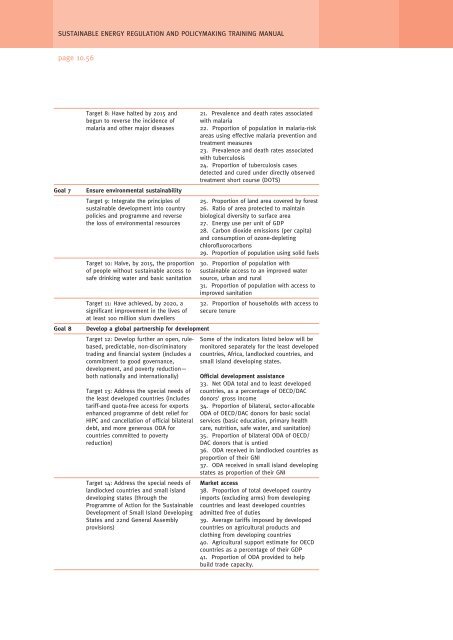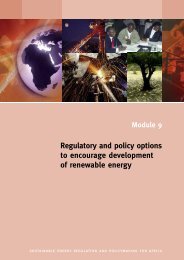Increasing access to energy services in rural areas - REEEP ...
Increasing access to energy services in rural areas - REEEP ...
Increasing access to energy services in rural areas - REEEP ...
Create successful ePaper yourself
Turn your PDF publications into a flip-book with our unique Google optimized e-Paper software.
SUSTAINABLE ENERGY REGULATION AND POLICYMAKING TRAINING MANUAL<br />
page 10.56<br />
Goal 7<br />
Goal 8<br />
Target 8: Have halted by 2015 and 21. Prevalence and death rates associated<br />
begun <strong>to</strong> reverse the <strong>in</strong>cidence of with malaria<br />
malaria and other major diseases 22. Proportion of population <strong>in</strong> malaria-risk<br />
<strong>areas</strong> us<strong>in</strong>g effective malaria prevention and<br />
treatment measures<br />
23. Prevalence and death rates associated<br />
with tuberculosis<br />
24. Proportion of tuberculosis cases<br />
detected and cured under directly observed<br />
treatment short course (DOTS)<br />
Ensure environmental susta<strong>in</strong>ability<br />
Target 9: Integrate the pr<strong>in</strong>ciples of 25. Proportion of land area covered by forest<br />
susta<strong>in</strong>able development <strong>in</strong><strong>to</strong> country 26. Ratio of area protected <strong>to</strong> ma<strong>in</strong>ta<strong>in</strong><br />
policies and programme and reverse biological diversity <strong>to</strong> surface area<br />
the loss of environmental resources 27. Energy use per unit of GDP<br />
28. Carbon dioxide emissions (per capita)<br />
and consumption of ozone-deplet<strong>in</strong>g<br />
chlorofluorocarbons<br />
29. Proportion of population us<strong>in</strong>g solid fuels<br />
Target 10: Halve, by 2015, the proportion 30. Proportion of population with<br />
of people without susta<strong>in</strong>able <strong>access</strong> <strong>to</strong> susta<strong>in</strong>able <strong>access</strong> <strong>to</strong> an improved water<br />
safe dr<strong>in</strong>k<strong>in</strong>g water and basic sanitation source, urban and <strong>rural</strong><br />
31. Proportion of population with <strong>access</strong> <strong>to</strong><br />
improved sanitation<br />
Target 11: Have achieved, by 2020, a 32. Proportion of households with <strong>access</strong> <strong>to</strong><br />
significant improvement <strong>in</strong> the lives of secure tenure<br />
at least 100 million slum dwellers<br />
Develop a global partnership for development<br />
Target 12: Develop further an open, rule- Some of the <strong>in</strong>dica<strong>to</strong>rs listed below will be<br />
based, predictable, non-discrim<strong>in</strong>a<strong>to</strong>ry moni<strong>to</strong>red separately for the least developed<br />
trad<strong>in</strong>g and f<strong>in</strong>ancial system (<strong>in</strong>cludes a countries, Africa, landlocked countries, and<br />
commitment <strong>to</strong> good governance, small island develop<strong>in</strong>g states.<br />
development, and poverty reduction—<br />
both nationally and <strong>in</strong>ternationally) Official development assistance<br />
33. Net ODA <strong>to</strong>tal and <strong>to</strong> least developed<br />
Target 13: Address the special needs of countries, as a percentage of OECD/DAC<br />
the least developed countries (<strong>in</strong>cludes donors' gross <strong>in</strong>come<br />
tariff-and quota-free <strong>access</strong> for exports 34. Proportion of bilateral, sec<strong>to</strong>r-allocable<br />
enhanced programme of debt relief for ODA of OECD/DAC donors for basic social<br />
HIPC and cancellation of official bilateral <strong>services</strong> (basic education, primary health<br />
debt, and more generous ODA for care, nutrition, safe water, and sanitation)<br />
countries committed <strong>to</strong> poverty<br />
35. Proportion of bilateral ODA of OECD/<br />
reduction)<br />
DAC donors that is untied<br />
36. ODA received <strong>in</strong> landlocked countries as<br />
proportion of their GNI<br />
37. ODA received <strong>in</strong> small island develop<strong>in</strong>g<br />
states as proportion of their GNI<br />
Target 14: Address the special needs of Market <strong>access</strong><br />
landlocked countries and small island 38. Proportion of <strong>to</strong>tal developed country<br />
develop<strong>in</strong>g states (through the<br />
imports (exclud<strong>in</strong>g arms) from develop<strong>in</strong>g<br />
Programme of Action for the Susta<strong>in</strong>able countries and least developed countries<br />
Development of Small Island Develop<strong>in</strong>g admitted free of duties<br />
States and 22nd General Assembly 39. Average tariffs imposed by developed<br />
provisions)<br />
countries on agricultural products and<br />
cloth<strong>in</strong>g from develop<strong>in</strong>g countries<br />
40. Agricultural support estimate for OECD<br />
countries as a percentage of their GDP<br />
41. Proportion of ODA provided <strong>to</strong> help<br />
build trade capacity.










